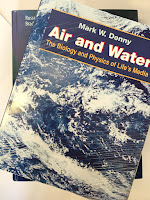Each year at this time, we are bombarded by top ten lists, such as “Top Ten News Stories of 2007” or “Top Ten Movies of the Year.” Russ Hobbie and I cite many excellent books in the 4th edition of
Intermediate Physics for Medicine and Biology. Below I list ten of my favorites. Other good books are cited in the
November 23 entry of my blog.
 Random Walks in Biology Howard Berg, 1983, Princeton University Press. This book is simply the best introduction to the role that diffusion plays in biology.
Random Walks in Biology Howard Berg, 1983, Princeton University Press. This book is simply the best introduction to the role that diffusion plays in biology.
 Air and Water
Mark Denny, 1993, Princeton University Press. A wonderful book that
covers some of the same topics we discuss in our first 10 chapters. It
approaches the material from the point of view of a physiologist with
some knowledge of physics, compared to our approach as physicists with
some knowledge of physiology.
Air and Water
Mark Denny, 1993, Princeton University Press. A wonderful book that
covers some of the same topics we discuss in our first 10 chapters. It
approaches the material from the point of view of a physiologist with
some knowledge of physics, compared to our approach as physicists with
some knowledge of physiology.
Machines in Our Hearts: The Cardiac Pacemaker, the Implantable Defibrillator, and American Health Care Kirk Jeffrey, 2001, Johns Hopkins University Press. More of a history book than an engineering book, it tells the fascinating story of how pacemakers and defibrillators were developed.
Electric Fields of the Brain: The Neurophysics of EEG Paul Nunez and Ramesh Srinivasan, 2005, Oxford University Press. The electroencephalogram from a physicists point of view.
Electricity and Magnetism Edward Purcell, 1985, Berkeley Physics Course, Vol. 2, McGraw Hill. Other E and M books may be more comprehensive (for example Griffiths or Jackson), but when I’m looking for insight I go to Purcell.
Statistical Physics Frederick Reif, 1964, Berkeley Physics Course, Vol. 5, McGraw Hill. I admire Reif’s statistical approach to thermodynamics. Much of Chapter 3 in our book follows the same path as Reif. It is a great choice for those looking for an introduction to statistical mechanics.
Div, Grad, Curl, and All That: An Informal Text on Vector Calculus H. M. Schey, 2005, Norton. A gentle introduction to vector calculus. Much more intuitive than other math books I know of.

Scaling: Why is Animal Size so Important? Knut Schmidt-Nielsen, 1984, Cambridge University Press. A delightful discussion of how physics and physiology conspire to constrain how large animals can become. See also his book How Animals Work.
Life in Moving Fluids Steven Vogel, 1992, Oxford University Press. One of the best introductions to biological fluid dynamics that I know. Vogel has many other fascinating books, including Vital Circuits about the circulatory system.
When Time Breaks Down Arthur Winfree, 1987, Princeton University Press. A book that had a huge influence on my own research on the electrical behavior of the heart. See also his book The Geometry of Biological Time, especially the second edition that contains updated information on cardiac electrophysiology.
Random Walks in Biology Howard Berg, 1983, Princeton University Press. This book is simply the best introduction to the role that diffusion plays in biology.
Air and Water Mark Denny, 1993, Princeton University Press. A wonderful book that covers some of the same topics we discuss in our first 10 chapters. It approaches the material from the point of view of a physiologist with some knowledge of physics, compared to our approach as physicists with some knowledge of physiology.











No comments:
Post a Comment